How to solder plastic pipes: a review of technology and a
To create a plumbing in an apartment or house today most often used polypropylene pipes. They are good, at least, because it is realistic to make the installation yourself and end up with excellent quality of the connections and the system as a whole. In this article we will look at how to solder plastic pipes with your own hands, what is important to consider here and what should be the optimal order of work.
To begin with, we will get acquainted with the general principle of the technology of connecting such a highway.

Brazing plumbing - what is it all about
In fact, everything is simple enough to understand - the parts of the system are interconnected using plastic pipe sleeves (these are, in fact, ordinary adapters in the form of a cylinder), angles or tees.
The joining of products occurs after heating the edges of the pipe and fitting. It turns out that the plastic is heated to the state when it begins to melt, and then the elements are interconnected and cool.

The physics of the process here is such that during cooling the material hardens, as if “merges” with each other and becomes a kind of monolith. As for the heating itself, the melting of polypropylene occurs due to the effect of temperature on it from a special soldering iron.
Such a gun for soldering plastic pipes is included in the electrical network, special cylindrical nozzles are heated on it, and polypropylene products are put on these nozzles. The fitting and the pipe are held on a soldering iron, and after the plastic has melted, the products are quickly removed and inserted into each other.
Tip! When you see how much such a pistol costs, you can consider that it is expensive and refuse to use this method of pipe installation. However, we do not recommend doing so - the method is excellent, and the tool can be hired. The price of this service in itself is low - and you need a soldering iron for a maximum of a couple of days.
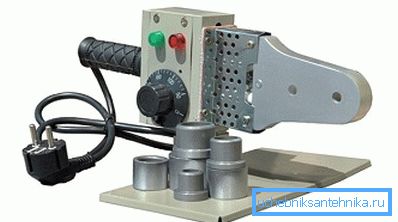
Let's take a look at the list of advantages of this connection technology - all data is provided in the table below.
| Advantage: | What does this mean in practice: |
| When molten polypropylene products are connected to each other and then solidify, they form a single product, as it were, without any cracks. Accordingly, there will be no exact leaks in such places, which means that the joint with the help of a spike can be used with an eye to the fact that the joints will be forever embedded in the walls, for example. |
| This refers to the fact that the places where soldered adapters are located have good resistance to mechanical shocks and pressure. That is, if you press the line at such points - it will not break in any way. |
| That is, during the soldering of elements inside the pipeline no hillocks, protruding seams, etc. are formed. And thanks to this property, the risk of growths and congestion is reduced. Accordingly, the water pressure in the system always remains normal. |
Well, if we talk about the shortcomings of technology, then we can distinguish such a common moment as the non-compliance by the masters of the time the effects of the soldering iron on plastic.
The fact is that if the product is overheated, then the docking will turn out to be untight, and if the heating was carried out less than it should be, then the elements simply “do not stick together” among themselves.

The whole secret is that the heating time varies depending on the diameter of the pipes. Below we have provided a table in which all the data regarding this moment are given.
| Diameter of polypropylene (all specified in millimeters) | Soldering iron exposure time (in sec.) | The time of pressing the plastic to each other (in sec.) | Duration of cooling and curing (in minutes) |
| sixteen | 7 | four | 2 |
| 20 | 7 | four | 2 |
| 25 | 7 | four | 2 |
| 32 | eight | 6 | four |
| 40 | 12 | 6 | four |
| 50 | 18 | 6 | four |
| 63 | 24 | eight | 6 |
| 75 | thirty | ten | eight |
This is the right temperature for soldering plastic pipes. Based on the numbers above, and you need to work with a gun.
Let's now consider in detail how the plumbing is actually mounted from plastic.
Self-brazing
Here it is worth noting that only those plastic pipes are soldered, which are produced in an even form. The material, which is sold in round coils (metal-plastic), is attached to each other using threaded fittings for pipes and welding is not used there.
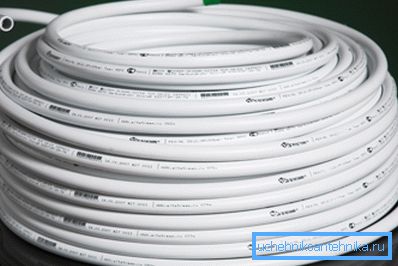
Well, now specific step by step instructions.
Preparatory work
The procedure here should be something like this:
- Before you solder the plastic pipe, you need to take the fitting and wipe it with a dry cloth.. The same should be done with the ends of the main line - this is done in order to remove organic particles from the surface of the plastic. If they remain on the plane, then after the soldering of products organic matter can rot, and this is already the risk of microcracks.
- Now you need to turn on the welding gun and heat it.. As a rule, when the temperature reaches the operating level, a special warning light turns off on the instrument.
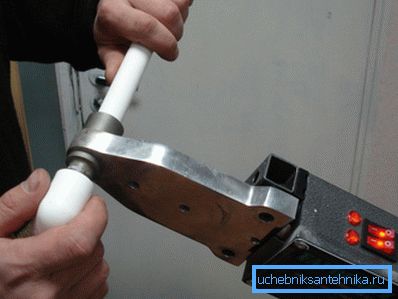
Please note that Teflon soldering tips (those that melt plastic) should be as clean as possible. If they are burnt, it will be very difficult to “remove” the fitting and pipe from the tool. And this is fraught with overheating of foam.
In general, the preparation is completed on this - you can proceed directly to the assembly of the system.
Soldering
To solder plastic pipes, proceed in the following sequence:
- Press the soldering iron to the floor so that the tool does not move when exposed to it.. As a rule, the gun has special legs that can be stepped on. But you can simply ask someone to hold the tool by the handle while you heat the foam.
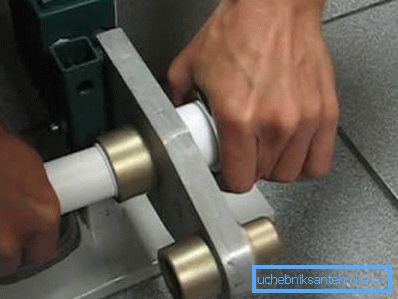
- "Push the fitting and pipe onto the teflon cylinders. Hold the necessary number of seconds and sharply remove the plastic from the soldering iron.
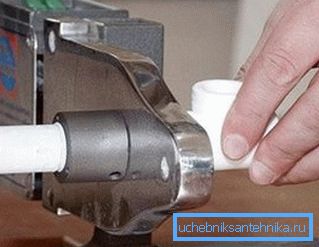
- Insert the elements into each other and lightly push them down.. Keep the items in the same position for 2 to 8 seconds (the time here, as you remember, depends on the diameter), and then release.

- Similarly connect all the elements of the highway.
Such is the scheme of work. This review of the technology is complete and now let's summarize.
Conclusion
As you can see, it turns out that soldering metal-plastic pipes is quite simple and everything can really be done independently. We gave you the basic data, an exemplary instruction of the work, too - we hope that you will use the information and apply it in practice. Well, if the “theory” seemed insufficient, then we recommend viewing the video in this article.